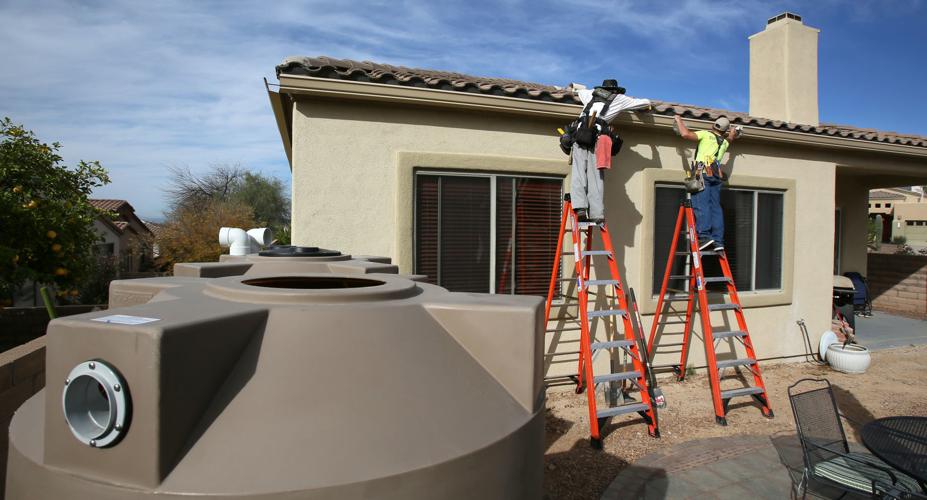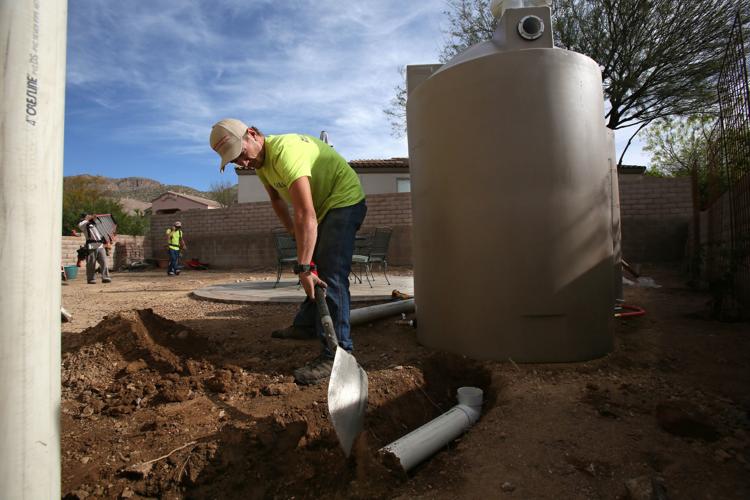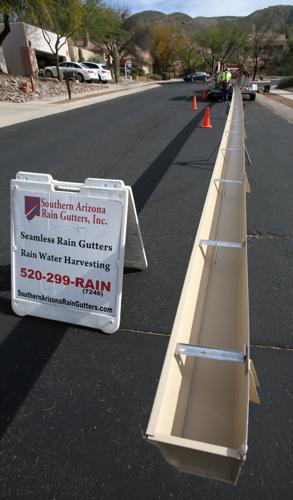City of Tucson rainwater-harvesting rebates, criticized before for not saving water, now save hundreds of homeowners an average of 10 percent in water use, officials say.
Tucson Water says its research found 720 homeowners in the rebate program save an average of 748 gallons per month using cisterns and other water-harvesting apparatus. For years and as recently as last summer, it found no net water savings from the rebates.
The city’s findings offer a big victory to water-harvesting advocates. They had felt officials’ past conclusions were narrow-minded because they didn’t take into account the benefits of rainfall-fed landscaping for climate-change adaptation and the heat-island effect. But the new research hasn’t quelled all concerns about the harvesting rebates, since they still cost far more per gallon of water saved than all other city water-conservation rebates.
But Tucson Water officials now stand firmly behind the water-harvesting rebates.
The program: Since 2012, Tucson Water has given homeowners up to $2,000 to buy cisterns, gutters and downspouts for “active” water harvesting: capturing rainfall off the roof.
The utility offers rebates of up to $500 for “passive” harvesting that reshapes a yard to capture runoff.
The utility has given nearly 2,000 homeowners rebates, costing nearly $2 million. These and other rebate costs are paid by a fee in water bills of 9 cents per 748 gallons used — scheduled to hit 10 cents by fiscal year 2019-20. Since 2014, the city has expanded the rebates to help businesses buy cisterns and neighborhoods to use curb cuts to suck water off city streets, and has started a loan program for low-income households.
The new research: The city looked at water use at homes whose owners have continuously lived in them since getting rebates. The analysis measured water use from 2009 to 2017, comparing individual homes’ use from three years before the systems were installed to one or more years afterward, said Tucson Water Director Tim Thomure.
Results: The city found “very significant correlation” between rainwater harvesting and reduced water demand, said Gary Woodard, a private hydrologist who conducted a statistical analysis on the matter. A utility staffer’s analysis drew similar conclusions, said Candice Rupprecht, Tucson Water’s water-conservation program manager.
“The size of the impact on demand was way more than their engineering estimate had suggested,” Woodard said last week.
Caveats: These savings are only being achieved by recipients who haven’t moved since they got rebates. Also, utility officials won’t be certain that these rebates are triggering water savings until they’ve analyzed two more years worth of recipients’ water use.
Previous results: The utility used to say that rebate recipients’ water savings were no greater than savings achieved by a control group of about 50,000 homes with similar water use patterns.
Explanation: When homeowners installed their rebate-financed cisterns, many planted new plants that needed more water than normal to get established, so now their use is dropping, Rupprecht said. Plus, 2014 had a long dry period, when rainwater tanks didn’t fill for many months, so use has naturally dropped since then, she said.
Another factor is that people often don’t just put in rainwater-harvesting systems and leave in their landscaping. Based on four or five workshops Woodard conducted for rebate recipients, “They’re redoing their whole landscaping, they are more conscious of the weather, the rain and how full or empty (their) tanks are. It’s not like you just set the irrigation timer and leave it alone for many months.”
Still high costs: The harvesting rebates have the third-highest total tab of nine city water-conservation rebate programs. That’s even though harvesting rebates didn’t start until three years after the general rebate program did, and even though five other rebate programs have had more participants.
Water-harvesting costs are high enough that the rebates’ total water savings are costing ratepayers more than $22,000 per acre-foot of water saved. By comparison, rebates for high-efficiency toilets in single family homes have saved 2,023 acre-feet total, for $1.49 million, at $736 an acre-foot. An acre-foot will supply four typical Tucson homes in a year.
The debate continues: Jane Evans, co-owner of Plants of the Southwest, which sells cacti and native succulents on Tucson’s north side, still disses the harvesting rebates as “a yuppie sort of thing to do.” She says ratepayer dollars should benefit the entire public instead of individual households buying cisterns, although she also supports high-efficiency toilet rebates that she says save right off the bat.
“It’s not that I think people who do water harvesting are bad. It’s that I have a problem with subsidizing a small number of people at the expense of the greater good,” Evans said.
Utility director Thomure, however, predicts harvesting rebate expenses per family will ultimately decline, partly because water savings typically increase over time in homes with rebates. He also expects costs will decline as more competitors enter the installation business.
When the utility evaluates rainwater harvesting’s effectiveness, it now looks at “a broad suite of criteria, not just how much water flows through the meter,” Thomure said. “We feel it is our role to look at things including climate-change adaptation and urban heat-island mitigation,” he said, which harvesting helps by nurturing native trees and shrubs.






